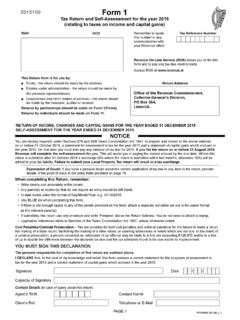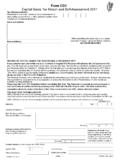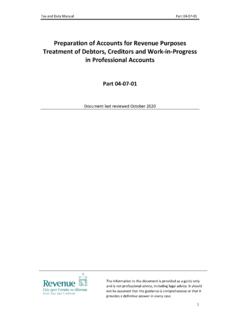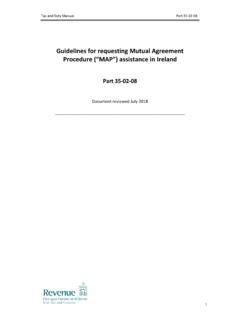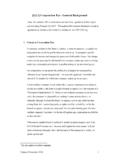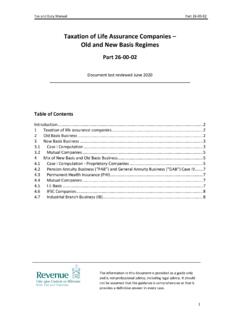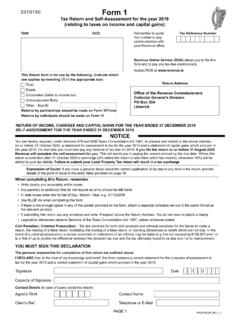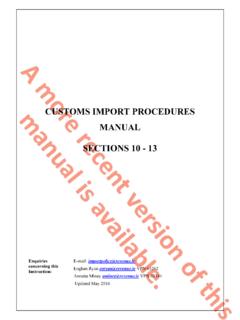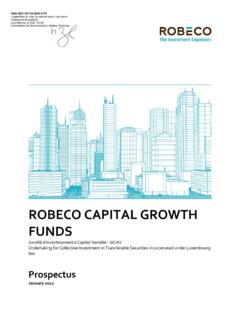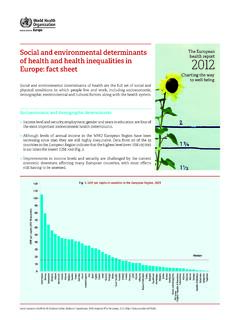Transcription of VIMA January 2022 - Revenue
1 VIES and INTRASTAT Trader s Manual Version 11 VIMA January 2022 2 Contents Foreword ..3 Contact Details ..4 Section I: VIES & VIES Appendices ..5 1. Introduction to VIES ..6 2. The VAT Information Exchange System (VIES) ..8 3. VIES Statement ..10 4. Zero-Rating of intra-Community Supplies and intra-EU VAT Number Validation ..15 5. VIES Action list for 6. VIES Penalties ..21 VIES Section II: INTRASTAT and INTRASTAT Appendices ..61 1. Introduction to INTRASTAT ..61 2. Treatment of INTRASTAT in particular 3. Specific Goods and Movements ..83 INTRASTAT Appendices ..89 3 Foreword This manual contains detailed information on the VIES and INTRASTAT regimes which came into effect on 1st January 1993 and has been updated to take account of all changes which have occurred since then.
2 This version (11) replaces all previous versions. Both regimes entail periodic submission by importers and exporters of certain information to VIMA about their trade with other EU countries. This manual is the definitive document and all traders are strongly advised to study it carefully. As regards VIES, there is no threshold. Each VAT registered trader who zero-rates goods and/or services to a VAT registered trader in another Member State must submit a VIES Statement regardless of value. As regards INTRASTAT, with effect from January 2016 the annual thresholds which trigger the obligation to make the more detailed monthly return are 500,000 for Arrivals (Intra Community Imports) and 635,000 for Dispatches (Intra Community Exports).
3 Should these thresholds change, a specification of the new thresholds will be published in Iris Oifigi il. This manual has been divided into two parts. Section I deals entirely with VIES; Section II deals entirely with INTRASTAT. 4 Contact Details Traders are encouraged to contact the VIMA team electronically through MyEnquiries. MyEnquiries is an online service that allows you to send and receive correspondence securely to and from Revenue . For VIES and INTRASTAT queries please select the MyEnquiries Category VIES, INTRASTAT and Mutual Assistance (VIMA) . Business customers who have a ROS digital certificate can access the service through ROS, using the My Services tab under 'Other Services'.
4 For more details see: MyEnquiries Telephone Enquiries VIES and INTRASTAT: +353 (0) 1 7383651 or +353 (0)42 9353300 (Please select option 1 for VIMA) Email Correspondence If a trader is not registered for ROS and the information required is not available on the Revenue website, please contact Revenue via email as follows: Intrastat or VIES filing enquiries Classification Section (Commodity Codes) ROS registration Postal Address VIMA, Government Offices, Millennium Centre, Dundalk, Co. Louth, A91 PP5W, Ireland. 5 Section I: VIES & VIES Appendices VIES Foreword The purpose of this part of the manual (Section I: VIES & VIES Appendices) is to explain in general terms the principle features of the VIES system and to update traders on all new developments and changes to that system since publication of the last guide.
5 It aims to give a broad overview of the VIES system. It focuses on those issues which are likely to be of interest to the majority of intra-Community suppliers and to those required to furnish a VIES Statement for the first time. It includes a comprehensive guide to filing on ROS. The information in this document is provided as a guide only and is not professional advice, including legal advice. It should not be assumed that the guidance is comprehensive or that it provides a definitive answer in every case. The relevant VIES legislation is contained in the various Acts, Regulations and Directives mentioned in paragraph of this VIES section of the manual.
6 6 1. Introduction to VIES Introduction In January 1993, frontier controls on the movement of goods between EU Member States were abolished and importers and exporters in EU trade no longer were required to complete customs documentation. Under Council Regulation (EEC) No. 218/92 of 27th January 1992, the EU Council established a system of administrative co-operation known as the VAT Information Exchange System (VIES) which was designed to prevent and deter abuse of the VAT zero-rating provisions for goods traded in the EU from 1st January 1993. An integral part of the VIES arrangements is a requirement that each Member State must store and process specific information which it collects from its traders about their trade with other Member States.
7 Details set out in paragraph Changes to VIES Arrangements From 1st January 2010 there were two important changes to the VIES arrangements. Council Directive 2008/8/EC introduced the reporting of Business-to-Business (B2B) services under the VIES reporting provisions. Council Directive 2008/117/EC introduced monthly filing of VIES returns for certain categories of traders. For the impact on VIES of the United Kingdom leaving the European Union please see Appendix 9. Trader Obligations This system places obligations on traders to submit periodic declarations of their trade to the VIMA unit of the Revenue Commissioners based in Dundalk, Co. Louth. Statements required for VIES relate only to the supply of goods and services to VAT registered traders in other EU countries.
8 From 1st January 2021 Supplies of Services to VAT registered traders in Northern Ireland are no longer reported on VIES Returns. Please see Appendix 9. 7 Domestic v Intra-EU Vat Numbers Revenue has developed a two-tier VAT registration system whereby you can apply for a domestic-only VAT registration or an intra-EU VAT registration. This change applies only to persons applying for VAT registration after 17th June 2019. Domestic only VAT registration applies to goods and services supplied and received in the State (for businesses not undertaking any intra-EU trade). Domestic only VAT registered traders do not make VIES returns. If you register for domestic-only purposes and subsequently wish to engage in intra-EU trade, you may then apply for an intra-EU VAT registration.
9 An intra-EU registration will facilitate intra-community acquisitions from, and reporting of intra-community supplies to, all EU Member States including Ireland. From 17th June 2019, where a new application for intra-EU registration is approved by Revenue , the trader will be automatically registered for VIES reporting obligations. All existing (pre-17th June 2019) VAT registered customers are deemed to be intra-EU VAT registered. These customers do not need to contact Revenue regarding their registration. The VIES system applies to intra-EU trade only. 8 2. The VAT Information Exchange System (VIES) VIES General VAT controls rely a great deal on the auditing of trader s commercial records (such as accounts, transport documents, invoices, settlement documents, etc.)
10 And on co-operation arrangements between Member States. Zero-rating of trade between Member States is conditional on the trader being in a position to show that the goods/services have in fact been supplied to an intra-EU VAT registered person/trader in another Member State. Other conditions are set out in paragraph below. VAT Information Exchange System The VAT Information Exchange System (VIES) put in place by the EU contributes to the effectiveness of the new VAT arrangements. It provides a mechanism whereby checks can be made in each Member State on the validity of claims to zero-rating and it helps to detect unreported movements of zero-rated goods between Member States.
